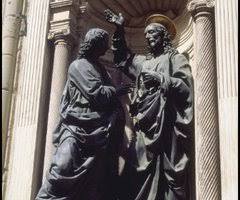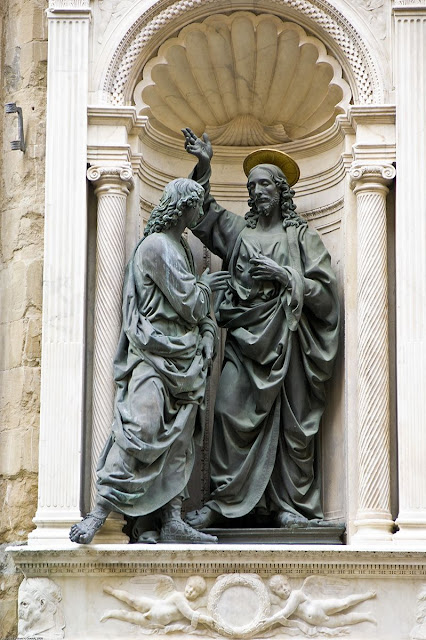ANDREA VERROCCHIO'S DOUBTING of THOMAS I
In 1467 Andrea Verrocchio is commissioned by the merchants' court of Florence to cast a bronze statue group of two figures, Saint Thomas and Christ, for a niche on the building of Orsanmichele in Florence. The entire enterprise takes almost twenty years to complete and in 1483 the two statues are placed in the niche. (The originals are in the Museum of Orsanmichele now and copies of both are placed outside the building.)
The moment the statues were created, they were praised by other artists. Cristoforo Landucci says that everyone considered the (Christ) (on the right) to be the most beautiful head of the Savior ever made.
The complexity of the composition and the graceful gestures of the two figures make them certainly the
loveliest statues that Verrocchio ever completed. And what a powerful juxtaposition of doubt with certainty!
What is the story he depicted here and why was it of interest to the commissioners? The story is one told after Christ has been crucified and after he has returned alive after death. He has several encounters with the disciples. The Book of John in the New Testament describes one of them with Thomas, who didn't believe Christ had survived the crucifixion.
Book of John, Chapter 21: 24-29: (from the King James version):
"But Thomas, one of the twelves, called Didymus, was not with them when Jesus came. The other disciples therefore said unto him, We have seen the Lord, But he said unto them, Except I shall see in his hands the print of the nails, and put my finger into the print of the nails, and thrust my hand into his side, I will not believe. And after eight days again his disciples were within, and Thomas with them: then came Jesus, the doors being shut, and stood in the midst, and said, Peace be unto you.
Then saith he to Thomas, Reach hither thy finger, and behold my hands, and reach hither thy hand, and thrust it into my side; and be not faithless, but believing.
And Thomas answered and said unto him, My Lord and my God.
Jesus saith unto him, Thomas, because thou hast seen me, thou hast believed: blessed are they that have not seen, and yet have believed."
I have underscored these words from the text in color because, in Verrocchio's version of the story, these exact words are written in Latin on the hems of the robes which Thomas and Christ are wearing.
The words from the Latin Vulgate text of the Bible on Thomas' robe are:
TU ES DOMINUS MEUS ET DEUS MEUS (You are my Lord and my God.)
The reply from Christ is written also in Latin on the hem of his robe from the bottom to the edge of his shoulder.
QUIA VIDISTI ME THOMA. BEATI QUI NON VIDERUNT ET CREDIDERUNT.
(You have seen me, Thomas. Blessed are those who have not seen me and yet believe.)

As if to emphasize his blessing of those who have not received tangible proof, Christ raises his right
hand with two fingers extended in blessing.

Thomas is the younger figure on the left. He steps forward onto his left foot and his right foot
swings into the viewers' space outside the niche where it originally stood. The swinging out of the right foot draws the spectator into the story and makes the story approachable and human.
With his left hand Thomas clutches the drapery of his robe and with his right hand, he reaches into the
open cut wound of Christ on his front chest.
Since the two statues were cast separately, his two fingers don't actually touch the wound but are very close to the skin. Not only does he almost touch the wound for
tangible proof but he looks down at it for
visible proof.
The words on the hems suggest that the viewer has already witnessed the resolution of Thomas'doubt since he says, You are my Lord and my God. Jesus's words also suggest the end of the story since he speaks of the people who have not yet known him and yet will believe he is the Son of God. The gestures of the two figures, however, point to a different moment in the narrative, not the end.
Thomas's body approaches the body of Christ and his feet are in motion in forward movement, as is his right hand. His right knee bends out toward the viewer under the voluminous drapery and his right index and middle fingers point to the wound opening; his head turns from his torso towards Christ and
his whole body appears to be moving.
Christ's feet rest on a plinth and his body seems alive but in repose, calm. The eager movement of
Thomas suggests his questioning, his disbelief, his need to know, need to touch in order to believe.Christ's body at rest suggests an answer, the ultimate answer, the utter belief that he has received wounds, has died, and has come back alive. The moment of the gestures appears to be the exact moment when Thomas is reaching to provide evidence for himself that Christ is truly alive.
Why would this dialogue of question and answer be a scene of interest to the merchants'court of Florence? Why, of all the Bible stories available to them, did they want this one in the niche of their guild? The Merchants' Court, the Mercatanzia or Mercanzia, had their own building for their proceedings (complete with jail) right next door to the Palazzo della Signoria in the center of town.
As a group, they must have had plenty of money from the cases which were adjudicated in their building because during the same period in which they commissioned this statue group from Verrocchio, they commissioned from the Pollaiuolo brothers and Botticelli a painted group of Virtues (1470) to be placed over the judges' benches in the room where cases were tried.
Their court settled disputes between merchants, disputes between sellers and buyers, and cases of misconduct by members of the guilds, but their main function was the adjudication of cases when Florentine merchants had dealings in foreign countries.
(See Antonella Astorri and David Friedman's interesting article in I Tatti Studies in the Italian Renaissance, Vol. 10 (2005), pp. 11-68.) In all their cases disputes had to be resolved by resorting to tangible and visible proof to reach the truth of a verdict. The requirement for tangible proof in the court meant that the story of St. Thomas was pertinent to their proceedings. Thomas had required tangible proof from Jesus in order to believe in his truth. The merchants required tangible evidence for the settlements of their disputes.
Unlike the Virtues that were private painted reminders of the qualities most associated with the Mercatanzia judges, the statues of St. Thomas and Christ were public reminders of theimportance of the Mercatanzia's methods of problem-resolution for the major industry, the cloth industry, in Florence and abroad.
The niche on Orsanmichele where the Verrocchio group stood is just above the heads of passersby on one of the busiest streets in the city, the street which leads from the secular center of town, Piazza della Signoria, to the sacred center of town, the Duomo. Orsanmichele, a building which
housed the grain supply for the town  and also held the most sacred of Madonna images,
and also held the most sacred of Madonna images,
combined both the secular and sacred in its functions. Orsanmichele was both silo and church.
Verrocchio is aware of the position of his two male figures in the town context. Thomas represents the secular (silo) questioning of faith and Christ represents the unquestioning acknowledgement of belief (the church.) Their two gestures swathed in large, sweeping folds of cloth, the cloth that was at the heart of Florentine industry and trade in the period,
allow the public that passes by to be reminded of the two major currents in their own lives, the reality of selling cloth to survive, and the reality of the Christian belief that underpinned all transactions related to that selling.
Verrocchio himself is selling faith, faith exhibited in the niche's subject, faith exhibited by his commissioners, faith in his own abilities to sculpt, faith in the story of Christ coming back after death, faith in the jurisdictions of the merchants' court itself. And the beauty of his figures transfixes the viewer, captivates and holds his/her attention. The artist here is the ultimate salesman, luring and seducing the audience to admire the version of the story as crafted in his hands. He knows that beauty is nourishment and his figures give satiation to the people who walk past them.
How beautiful the concepts of justice and belief!
The artist even left a foot out for you to reach up and touch, in case seeing the beauty were not enough.
























































